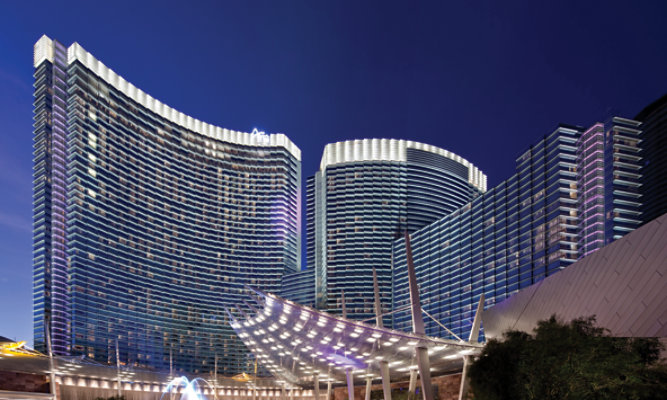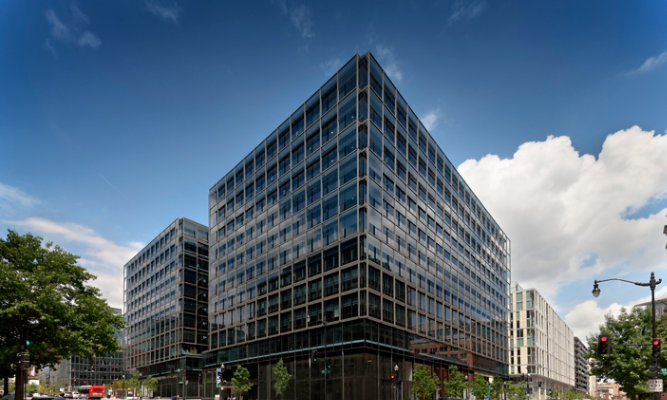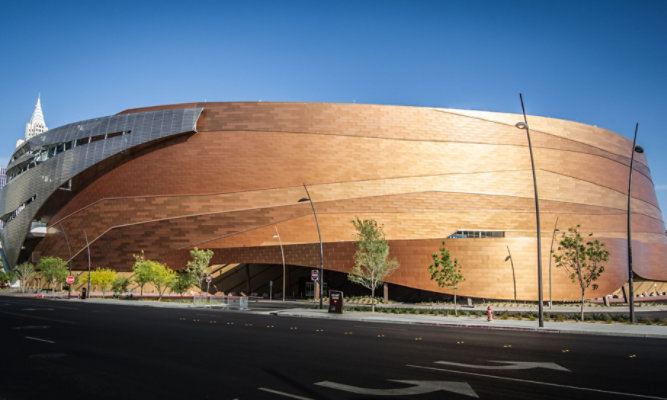From Drab to Daring: A Study on the Explosion of Color in Coatings
Take a moment and visualize some of the world’s most famous skylines — from New York City to Hong Kong, Chicago to Dubai. The iconic buildings on each horizon are wondrous to behold, but which color stands out in your mind’s eye? Historically, the use of vibrant colors has been slim among architects, resulting in our view of skylines to be monochromatic. But as architects continue to test what is considered the norm in major construction projects, color has made a breakthrough as a way to further enhance the aesthetic of a building.
Creating vibrant coatings was once a technically challenging process for coating manufacturers, but now thanks to new developments in the chemical make-up, along with extensive research on color selections and trends, we’ve enhanced the offerings for those seeking unique finishes. Over the last ten years, the use of radiant colors for both entire exterior finishes and accents has steadily increased. Architects now have a wide variety of options and the ability to customize coating colors and textures, giving way to a flurry of innovative and resplendent building designs.
The State of Colors
In general, color is experiencing an artistic renaissance in our culture, which is slowly making its way into the architectural arena. With the historic popularity of monochromatic design, color has become an effective tool to enhance architecture, create individuality, and bring attention to a building in an otherwise drab skyline. A bold example of this trend can be found in West Hollywood, where a multifamily housing unit, Formosa 1140, features a striking custom coating combination of Coronado Red and Raucous Orange. The apartment complex’s bright red exterior highlights not only the steady revitalization of West Hollywood, but also the successful implementation of vivid exterior metal coatings.
One of the principal reasons dynamic colors are beginning to take off is due to the technology that is now available to create durable coatings while using intense pigments — furthering the ability to achieve a wider range of colors and innovative effects. With a growing popularity surrounding Pantone© and an overall expansion of color palette preferences from architects and homeowners, enhancements in the chemistry of coatings is bridging the gap between rising demand and available product.
Determining New Colors
To adequately service the escalating interest in diverse color selections for PVDF coatings, time and energy must be committed to the study of what and why certain hues are trending. At Valspar, a vast amount of research goes into the selection of new coating colors — both with investigative companies exploring market research and in-house color experts. These experts provide insight not only on what colors are becoming popular, but why. The entire process allows coating manufacturers to become part of the conversation on color, and adequately respond to architectural and design trends.
Furthermore, market demand breeds conversations discussing the possibility for new colors and custom creations. Architects and builders often find inspiration from nature and art, which propose unique opportunities for coating manufacturers to replicate. Recent successes resulting from this discussion were the development of our Rustica and Nova color series. The Rustica family features a soothing, nature-inspired palette of rich polychromatic colors. Featuring a subtle color-shift and a wide offering of warm, earthy tones, Rustica is just one of the many results that have emerged from research on color trends, market demand and the ever-changing advancement in technology.
The Rustica family features a soothing, nature-inspired palette of rich polychromatic colors. Featuring a subtle color-shift and a wide offering of warm, earthy tones, Rustica is just one of the many results that have emerged from research on color trends, market demand and the ever-changing advancement in technology.
Similarly, Nova is another groundbreaking coating color family that can be matched to nearly any color — including neutrals, bright colors, pastels, whites and black — with a gold or silver sparkle finish. In the past, adding sparkle meant sacrificing color intensity, but with advancements in this coating’s chemistry, architects and building owners can achieve lustrous hues without sacrificing the durability.
New Coating Technology
For many years, architects and building owners used a plethora of oranges, yellows and reds in their design schemes, but had to stop because they contained lead and cadmium. Thereafter, these colors weren’t a viable option for metal coatings, and despite their ability to achieve vivid warm tones, the side-effects made them unusable and dangerous. However, with recent developments in pigment technology, many of these former colors of glory have been recaptured, and seen a resurgence in use.
Manufacturers continue to advance technologies in order to expand the spectrums of rich, vivid pigments, while upholding the eco-friendly and durability features known of architectural coatings. Of the many recent innovations, pearlescent, color-shift, prints and textured headline those noticing the most intrigue and growth.
Pearlescent coatings are a unique finish that gives the illusion of depth and sparkle to a building exterior. Composed of specially formulated mica flakes and nontoxic pigments, this unique coating brings a whole new dimension to color by adding a nearly three dimensional appearance. Pearlescent coatings are growing in popularity for metal paneling, as well as aluminum extrusions, mullions, soffits, fascia, skylights and curtainwalls. Not only can pearlescent coatings provide a unique dimension to a building’s exterior, they can also be used as tasteful accents. Pearlescent coatings like Nova and Rustica can be customized to match nearly any color, and vary the intensity and subtlety of depth and sparkle effects.
Another escalating trend is color-shifting coatings, which offer an absorbing, bilateral finish to building exteriors. Color-shift coatings contain a base layer combined with added pigments that reflect light, which cause our eyes to see different colors from different angles. From a rural home in California, to Florida’s Exploration Tower at Port Canaveral, color shift coatings are just beginning to take off in both the commercial and residential markets, and are bound to become more and more prevalent.
Pattern and textured coatings have also seen a significant uptick in the last 3-5 years and are accomplished through the coil coating process. Print rollers with embedded designs are imprinted onto metal paneling with complementing color. Particular appearances like wood shake, slate, and tile are among some of the most popular selections now available on the market. Many of these unique textures redirect light for enhanced visual depth, promising a quality alternative to a more traditional flat-panel appearance. Often used on roofs, pattern and texture coatings are also being combined with the ever-expanding color roster to bolster designs and produce truly innovative architectural creations.
All three of these unique innovations are contributing to the overall increased application of colorful PVDF coatings across various architecture projects. Combined with the growing trend in use of colors for accent, these new developments provide an added dimension to design and can greater highlight areas of buildings not often emphasized in architectural design.
Color Coatings in Action
Opening in 2015, the Buerger Center for Advanced Pediatric Care became the latest expansion of The Children’s Hospital of Philadelphia (CHOP) campus, a complex that sees more than 200,000 patients every year. Spearheaded by Pelli Clarke Pelli Architects and FKP Architects, the 700,000 square-foot facility serves as a shining example of how vivid color coatings are now being implemented into architectural design.
The addition features a curving curtain wall system clad in a total of nine vibrant colors of Valspar’s high-performance Fluropon®coating. Hand-selected by the architects, the colorful palette creates a welcoming and fun environment for its many patients.
Designed by Baker Metal Products Inc. and installed by Enclos Corp., the unique, multi-color curtain wall was one of the defining components general contractor Turner Construction Co. had to manage as part of the $425 million project. Five types of unitized curtain wall systems spanning 151,000 square-feet were commissioned for CHOP’s Buerger Center. Valspar’s 70 percent PVDF resin-based Fluropon coatings were selected to finish the aluminum framing not only for their diverse color palette, but also for their ability to provide long-lasting performance and color retention. The bright Fluropon coatings generate stunning horizontal accents across the structure, creating a smooth connection between the curtain wall and soffits as the colors change at each floor, interchanging between orange, blue, red, yellow, green and purple.
The remainder of the metal framing on CHOP’s Buerger Center is finished in Fluropon Silver Pearl using a four-coat system on the exterior building components and a three-coat system on the interior building components. One of the many neutral tones that dominate sales, Fluropon Silver Pearl is perfectly implemented on the structure as a backdrop for the livelier colors to burst forth.
The new CHOP Buerger Center is just one of many new buildings being constructed across the country that feature dynamic colors. Whether it’s the vibrant accent tones like the curtainwall system of the Center, or a full-fledged color exterior like the Formosa 1140 apartment complex in West Hollywood, advances in research and coating technology are spurring a revolution of colorful construction. Next time you look up at the skyline of your favorite city, take an extra moment to take it in — there may be an extra splash of color that wasn’t there before.
Editor's Note: This article was originally published on June 17, 2016. Valspar was acquired by The Sherwin-Williams Company on June 1, 2017.
Architectural Projects
Get Inspired
Sherwin-Williams has collaborated with architects and building product manufacturers around the globe to help bring monumental architecture to life in vibrant color that withstands the test of time.
View all of our projects

